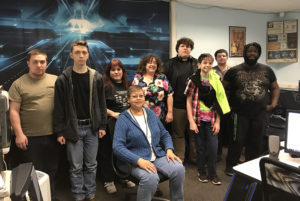by Eli Ruiz
LOCH SHELDRAKE – SUNY Sullivan celebrated Earth Day with a number of interesting events, including a national competition called the Arctic Climate Game Jam.
The Arctic Climate Game Jam was inspired by the 2016 Arctic Science Ministerial meeting, which brought together Science Ministers from 24 countries to discuss Arctic research themes and develop international science collaborations. A key theme of the meeting focused on using Arctic science as a vehicle for STEM education and citizen empowerment.

PHOTO BY ELI RUIZ
According to official event literature, the Arctic Climate Game Jam involves teams from different colleges and universities “gathering to rapidly design game prototypes (online, pervasive, tabletop, or other formats) that make learning about climate change more fun, engaging, and accessible to a range of audiences.”
SUNY Sullivan’s team was led by the college’s dynamic computer science and information systems professor, Dr. Cynthia Marcello, and featured a mix of six computer programming, simulation game development, graphic design and various other computer and technology-related majors.
The crew began creating their climate-related video game on April 21, agreeing on a rather short three-day window for completion.
The first day was spent culling real-world information from Columbia University climate researchers.
“We wanted players to have a true experience playing our game,” said Dr. Marcello during an April 22 interview with the Sentinel. Dr. Marcello said on April 22, “It was just logical for us to include real world climate data [in the game].”
Next, the team had to pick a demographic to target with their creation. “We decided to focus the game on middle-school-age kids,” Dr. Marcello offered. “With the added benefit that if a parent wants to watch or play along with the child, I believe older folks can learn from it as well.”
With a host of climate issues affecting the Arctic region, Dr. Marcello and her team decided to focus gameplay on three specific animals: the polar bear, the albatross, and the narwhal – a medium-sized toothed whale with a tusk-like protruding canine tooth.
As for concept, the team decided on recreating each species’ respective “journey,” as Dr. Marcello put it.
“We felt that creating a journey that each animal would actually go through would work really well in a video game with levels,” she explained.
The second day saw the game’s build out, no easy task according to Dr. Marcello.
“The game is easy at first,” added senior simulation game development major Sean Saylor. “But as you progress through the different levels the litter grows and the animals’ food supply shrinks… it becomes more and more difficult for them to meet their needs.”
“People just don’t know how much work actually goes into something like this,” Dr. Marcello said.

Not only do the featured characters have to be built from scratch, but the team also has to consider and tweak such aspects as the physics of the wind, water and any moving object featured in the game, which as of the Sentinel’s visit had yet to be named.
“We’re striving for as much realism as we can accomplish,” said freshman and simulation game design major Blaise Camacho, whose tasks involved water physics. “It’s a lot… but it’s a lot of fun too.”
The third day was “completion day.”
“Sunday game development went well, however we still have about another 8-10 hours of development to do before we finish,” Dr. Marcello told the Sentinel in an e-mail interview. “We will reconvene this coming Friday to accomplish this .”
A seeming win-win, the Arctic Climate Game Jam not only helped Dr. Marcello’s students refine their coding skills, but the final product presents one of the more novel mediums to be used to raise awareness in a decidedly important demographic toward the many perils our environment may face in the future.
“Games are an effective digital storytelling medium suitable for people of all ages to learn about the many areas of climate change, environmental issues, and other related causes that need increased awareness,” Dr. Marcello said. “By providing a safe environment for the player to experience changes of state in a simulated world, the player becomes more aware of the issues without being harmed in the process. Reaching the player at an emotional level is necessary to encourage lifelong changes in behavior. This is how games serve to educate the player.”
